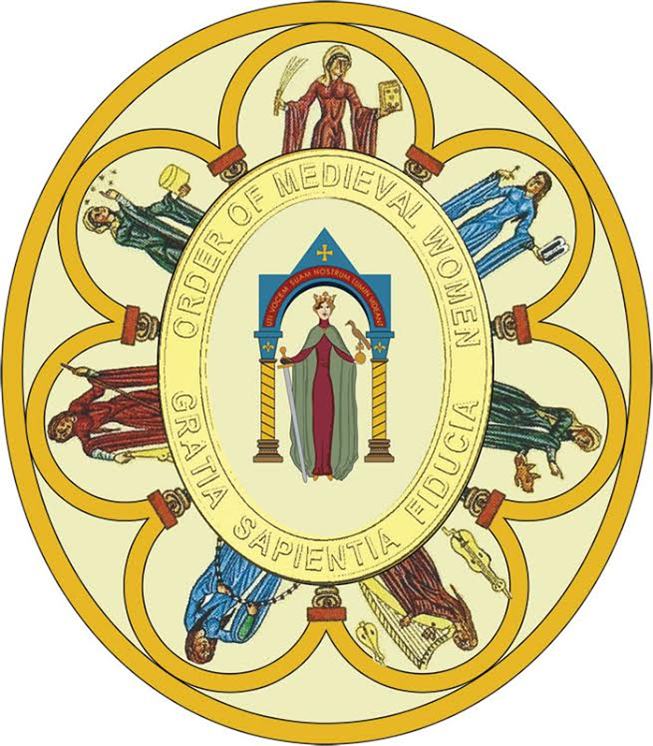Welcome to the Order of Medieval Women
Born into a world dominated by men, these women disregarded society’s precept to pursue their own aspirations or exigency influencing arts, science, literature, judiciary, military, religion, and government to the benefit of humanity of their time.
Motto: “We cannot live in a world that is interpreted for us by others...use our own voice, see our own light.” - St. Hildegard von Bingen, 1098 - 1179
Motto: “We cannot live in a world that is interpreted for us by others...use our own voice, see our own light.” - St. Hildegard von Bingen, 1098 - 1179
Our insignia signifies contributions made by our “Women of Consequence” towards shaping their world. Seals were placed on documents as a mark of authenticity and form our insignia's center surrounded by the 7 liberal arts muses who personify a collaboration of thinkers such as Pythagoras, Plato, and St. Augustine with the subjects they considered essential knowledge and later endorsed by medieval society. The Latin words, Grace, Wisdom and Courage are included in the lower portion of the seal, universal traits exhibited by each our Medieval Women.
The seal’s castle entrance from La Vita Mathildis,ca 1115, Donizoe di Canossa, Vatican Library, portrays military, political, economic and legal power while acknowledging Matilda of Tuscany’s major role as defender of reforming the papacy. Prominently positioned at the top of the pediment is the cross patté, the universal symbol of Christianity, often associated with the Knights Templar and found in many ceremonial crowns, over a Latin quote by Hildegard de Bingen, “use our own voice, see our own light.” The two Solomonic columns, a design Constantine I brought from Solomon’s Temple to Rome about 300 AD, support capitals bearing a stylized fleur-de-lis , a medieval symbol representing society’s social order: those who work, those who pray, those who fought. Our central female figure mirrors Eleanor of Aquitaine, one of the most notable figures of the Middle Ages from her 12th century seal holding the “Globus Cruciger,” signifying triumph of Christ’s authority over the world. The falcon perched on top of the Globus Cruciger indicates nobility, her right hand bears a sword demonstrating a women’s role as both one of power and protector.
The seven muses personify the liberal arts representing the classical education taught in medieval universities, Hortus deliciarum, ca 1180, Herrad von Landsberg, an Alsatian nun. Starting clockwise from 12:00 Grammar, holding a book and a whip, Rhetoric, a tablet and stylus, Dialectic, points with one hand and the other holds a barking dog’s head—”my arguments are followed with speed, just like the dog’s barking,” Music, a harp amidst other instruments, Arithmetic, a beaded cord like a rudimentary abacus, Geometry, a staff and compass and finally Astronomy, looks to heaven through a magnifying lens.
The seal’s castle entrance from La Vita Mathildis,ca 1115, Donizoe di Canossa, Vatican Library, portrays military, political, economic and legal power while acknowledging Matilda of Tuscany’s major role as defender of reforming the papacy. Prominently positioned at the top of the pediment is the cross patté, the universal symbol of Christianity, often associated with the Knights Templar and found in many ceremonial crowns, over a Latin quote by Hildegard de Bingen, “use our own voice, see our own light.” The two Solomonic columns, a design Constantine I brought from Solomon’s Temple to Rome about 300 AD, support capitals bearing a stylized fleur-de-lis , a medieval symbol representing society’s social order: those who work, those who pray, those who fought. Our central female figure mirrors Eleanor of Aquitaine, one of the most notable figures of the Middle Ages from her 12th century seal holding the “Globus Cruciger,” signifying triumph of Christ’s authority over the world. The falcon perched on top of the Globus Cruciger indicates nobility, her right hand bears a sword demonstrating a women’s role as both one of power and protector.
The seven muses personify the liberal arts representing the classical education taught in medieval universities, Hortus deliciarum, ca 1180, Herrad von Landsberg, an Alsatian nun. Starting clockwise from 12:00 Grammar, holding a book and a whip, Rhetoric, a tablet and stylus, Dialectic, points with one hand and the other holds a barking dog’s head—”my arguments are followed with speed, just like the dog’s barking,” Music, a harp amidst other instruments, Arithmetic, a beaded cord like a rudimentary abacus, Geometry, a staff and compass and finally Astronomy, looks to heaven through a magnifying lens.
